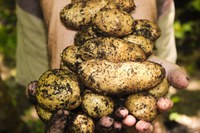Dakota Gardener: Bountiful harvest, plenty of love
(Click an image below to view a high-resolution image that can be downloaded)
By Kelsey Deckert, horticulture agent
NDSU Extension - Burleigh and Morton Counties
We are in full swing of harvesting in our gardens.
Although our growing season got off to a slow start, most gardens in the Dakotas are producing an abundance of tomatoes, potatoes, cucumbers and other produce now. This is a great opportunity to express our love with our family and friends by sharing our bountiful harvest.
It feels wonderful to share, but there is only so much produce that family and friends are willing to take off your hands. We all know the running joke of leaving zucchinis on doorsteps or in vehicles.
What else can you do with your extra produce?
I start out by upping my game with recipes. Let me tell you there are plenty of zucchini recipes out there. Even so, there’s only so many zucchini casseroles, breads and cakes my family can tolerate.
Consider preserving your garden produce. Vegetables can be frozen, canned, dried or stored over winter. It is a wonderful way to enjoy the taste of homegrown vegetables throughout the winter.
After harvesting your fill of vegetables, you may be tempted to pull out the plants and get a jumpstart on cleaning up the garden. But is this really the last option?
The answer is no.
You can continue spreading the love by donating to local food pantries. Nothing fills your heart and a person-in-need’s plate more than donating the extra produce you have in your garden.
According to feedingamerica.org, 34 million people and 9 million children in the U.S. are food insecure. If you look at North Dakota alone, 42,290 people are facing hunger with 13,690 being children. That means 1 in 18 people and 1 in 13 children face hunger. Those are some alarming statistics.
There are many food pantries and soup kitchens throughout North Dakota that will accept donated vegetables. Even if you reside in a rural area, many churches will take food donations.
If you are looking to make a difference with food insecurity, you might consider growing a Hunger Free Garden next year. It can be as simple as adding an extra row in your garden or dedicating a whole plot to donation. More information about the Hunger Free ND Garden Project is available at https://www.ndda.nd.gov/divisions/business-marketing-information/local-foods/hunger-free-nd-garden-project.
For more information about gardening and local donation sites, contact your county NDSU Extension agent. Find the NDSU Extension office for your county at www.ndsu.edu/agriculture/extension/county-extension-offices.
NDSU Agriculture Communication – Aug. 29, 2023
Source: Kelsey Deckert, 701-221-6865, 701-667-3340, Kelsey.j.deckert@ndsu.edu
Editor: Kelli Anderson, 701-231-7881, kelli.c.anderson@ndsu.edu




